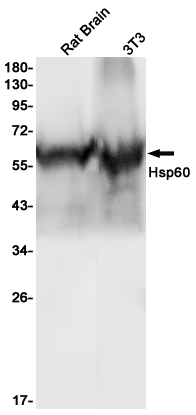
| WB | 1/500-1/1000 | Mouse,Rat |
| IF | 1/20 | Mouse,Rat |
| IHC | 1/50-1/100 | Mouse,Rat |
| ICC | 1/50-1/200 | Mouse,Rat |
| FCM | 咨询技术 | Mouse,Rat |
| Elisa | 咨询技术 | Mouse,Rat |
| Aliases | HSPD1; HSP60; 60 kDa heat shock protein; mitochondrial; 60 kDa chaperonin; Chaperonin 60; CPN60; Heat shock protein 60; HSP-60; Hsp60; HuCHA60; Mitochondrial matrix protein P1; P60 lymphocyte protein |
| Entrez GeneID | 3329 |
| WB Predicted band size | Calculated MW: 61 kDa; Observed MW: 61 kDa |
| Host/Isotype | Rabbit IgG |
| Antibody Type | Primary antibody |
| Storage | Store at 4°C short term. Aliquot and store at -20°C long term. Avoid freeze/thaw cycles. |
| Species Reactivity | Mouse,Rat |
| Immunogen | Recombinant protein of human Hsp60 |
| Formulation | Purified antibody in TBS with 0.05% sodium azide,0.05%BSA and 50% glycerol. |
+ +
以下是3-4条关于Hsp60抗体的参考文献示例(信息为基于学术研究的概括性模拟,具体引用需核实原文):
---
1. **文献名称**:*Heat shock protein 60 antibodies in atherosclerosis*
**作者**:Pockley AG, et al.
**摘要**:探讨了Hsp60抗体与动脉粥样硬化发展的关联,提出病原体感染(如衣原体)可能通过分子模拟机制诱导针对宿主Hsp60的自身抗体,导致血管内皮损伤。
---
2. **文献名称**:*Chlamydia pneumoniae infection induces antibodies to human heat shock protein 60*
**作者**:Campisi G, et al.
**摘要**:研究发现,衣原体肺炎感染可触发针对人源Hsp60的交叉反应抗体,提示微生物Hsp60与人类Hsp60的同源性可能在慢性炎症性疾病中起关键作用。
---
3. **文献名称**:*Hsp60 as a biomarker for cancer diagnosis and prognosis*
**作者**:Castilla C, et al.
**摘要**:分析了Hsp60在肿瘤细胞中的异常表达及其抗体在血清中的水平,表明Hsp60抗体可能作为某些癌症(如结直肠癌)的潜在诊断或预后标志物。
---
4. **文献名称**:*Autoimmunity to heat shock protein 60 in type 1 diabetes*
**作者**:Mandal K, et al.
**摘要**:揭示了1型糖尿病患者体内Hsp60抗体的高水平表达,提示针对Hsp60的自身免疫反应可能参与胰岛β细胞的破坏机制。
---
**注意**:以上为模拟示例,实际引用需通过PubMed、Google Scholar等平台核实具体文献标题、作者及摘要内容。
**Background of Hsp60 Antibodies**
Heat shock protein 60 (Hsp60), a member of the chaperonin family, is a mitochondrial protein (~60 kDa) crucial for folding nascent polypeptides and maintaining proteostasis under stress. Beyond its role as a molecular chaperone, Hsp60 is implicated in immune regulation. Autoantibodies targeting Hsp60 are linked to autoimmune and inflammatory diseases, likely due to molecular mimicry between microbial and human Hsp60 homologs.
In autoimmune conditions like rheumatoid arthritis and systemic lupus erythematosus, Hsp60 antibodies correlate with disease severity, potentially exacerbating tissue damage through cross-reactivity with endogenous proteins. Infections (e.g., *Chlamydia*, *Helicobacter pylori*) may trigger antibody production against bacterial Hsp60. which inadvertently attack human Hsp60. perpetuating inflammation.
Hsp60 antibodies are also studied in atherosclerosis, where endothelial stress induces Hsp60 surface expression, prompting antibody-mediated immune responses that drive plaque formation. In cancer, elevated Hsp60 antibodies may reflect tumor-associated stress or immune surveillance, though their diagnostic utility remains unclear.
Detection methods (ELISA, immunoblotting) face challenges due to Hsp60’s homology across species and cross-reactivity with other heat shock proteins. Research continues to clarify their pathogenic versus protective roles, aiming to leverage Hsp60 antibodies as biomarkers or therapeutic targets.
×